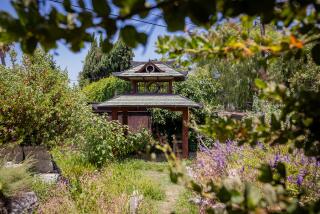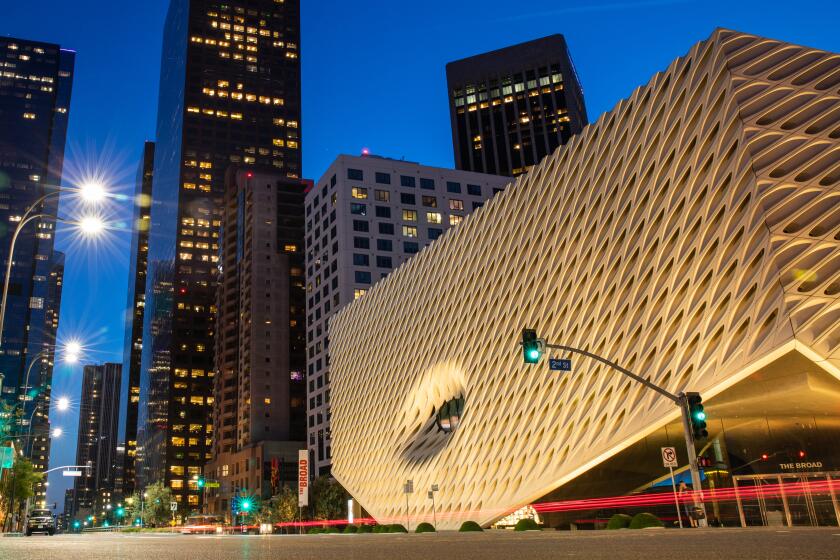Aquarium Construction Firm Gives Nature Helping Hand in Long Beach
- Share via
Let’s say you want to build a natural-looking habitat for sea lions, sharks and other fish at the mouth of the Los Angeles River.
Don’t laugh.
The Long Beach Aquarium of the Pacific is doing it.
So, whom to call?
Certainly not Mother Nature. She got the brushoff in this heavily industrialized area years ago.
Long Beach decided to grab Tucson’s Larson Co., the people who re-create tropical rain forests, coral reefs, polar ice caps and desert ecosystems in places like the Bronx, N.Y., Memphis, Cleveland and the Mall of America in Minneapolis.
Larson is creating or importing everything from the wave action inside the aquarium to the saltwater in the fish tanks.
“Our motto is, ‘Is it real or is it Larson?’ ” said Natalia Lederer, one of the artist / construction workers brought to Long Beach by the Larson Co., a “creative solutions” firm that has created marine habitats in aquariums all over the world.
But the firm doesn’t stop at aquariums. It also does underwater grottoes in hotels, live shark tanks and fake trees for casinos, and those eye-catching jagged rock outcroppings and waterfalls that dot some desert golf courses.
The thinking in Long Beach went sort of like, “Hey, if they can build replicas of the primitive Easter Island statues in front of the Tropicana Hotel in Las Vegas and do a jungle temple in Memphis, why not a copy of a Micronesian barrier reef in Long Beach?”
The company, after all, is the same one that re-created a tropical rain forest in the Bronx Zoo.
Larson specializes in what it likes to call “edutainment,” a blend of educational and entertainment values, said Harold Schifman, the company’s president and chief executive officer.
Schifman says the next big operative word in his business is “eatertainment.” He envisions themed restaurants like Planet Hollywood and the Hard Rock Cafe dotting the planet. “What we are moving into is a themed world,” he said.
But at least in Long Beach, the firm is keeping the educational component uppermost in mind. You won’t see goofy-looking sea serpents at the bottom of aquarium tanks.
That is why you will find the crew of artisans and construction workers from Larson painstakingly re-creating the ocean floor, mussel by mussel, coral outcropping by coral outcropping under the watchful eye of aquarium zoologists and curators. Some of the starfish on the ocean floor will be phonies, as will the ribbons of seaweed floating up from the bottom of the fish tanks, but the idea is to make sure the public won’t be able to tell.
Long Beach city leaders are investing $117 million in the aquarium building and millions more in parking and other structures.
The aquarium is on landfill on a site that was once underwater. Out front, a harbor is being sculpted by earthmovers, and officials hope the new lagoon will be completed in time for the aquarium’s scheduled opening next summer.
City leaders hope the displays of marine life will be entertaining enough to bring tourists to the city in droves. But they also decided early on to re-create marine life as accurately as possible so the aquarium will be of value educationally to schools in Southern California.
Ken Yates, a zoologist charged with populating the aquarium with 550 species of marine life, said the aquarium took two Larson workers to Palau, in Micronesia, to study and photograph underwater coral formations they wanted duplicated in Long Beach almost exactly as they appear in nature.
Ultimately, Yates said, the aquarium hopes to grow its own coral. But for now it will settle mostly for the handmade stuff produced by artisans working for the Arizona firm.
“They have been working in aquariums a long time,” Yates said. “They have techniques and skills to mimic nature.”
The artisan / construction workers paint, mold, bend iron, stitch together webbing and lay plaster, concrete and epoxy over it until they get just the look they are after.
Lederer, 54, a longtime sculptor and artist who has advanced art degrees from schools in Europe, said she knew about art but had to learn about laying concrete, lathing and working with iron and plumbing when she went to work for Larson seven years ago.
Interviewed recently at the construction site, where she was wearing paint-spattered jeans, a T-shirt from a Santa Monica fish taco restaurant and a bandanna under her hard hat, Lederer said she and others have exhaustively studied marine life and try to duplicate it exactly.
Take the aquarium exhibit that will feature puffins, diving birds whose natural habitat is the Bering Sea.
The trick is to build natural enough nesting areas so the birds don’t kill each other over the one or two choice nesting spots.
“In the wild, they have whole mountains but choose just the right crack for a nest,” Lederer said. “You better have a crack just like the ones they like, or they won’t build a nest.”
Last week, Lederer was part of the team re-creating the Micronesian coral reef in Long Beach. This week she is finishing a job in Las Vegas where she helped build a four-story-high replica of the Trojan horse for a major casino.
Lederer said: “We have become known in the field as being able to do anything.”






